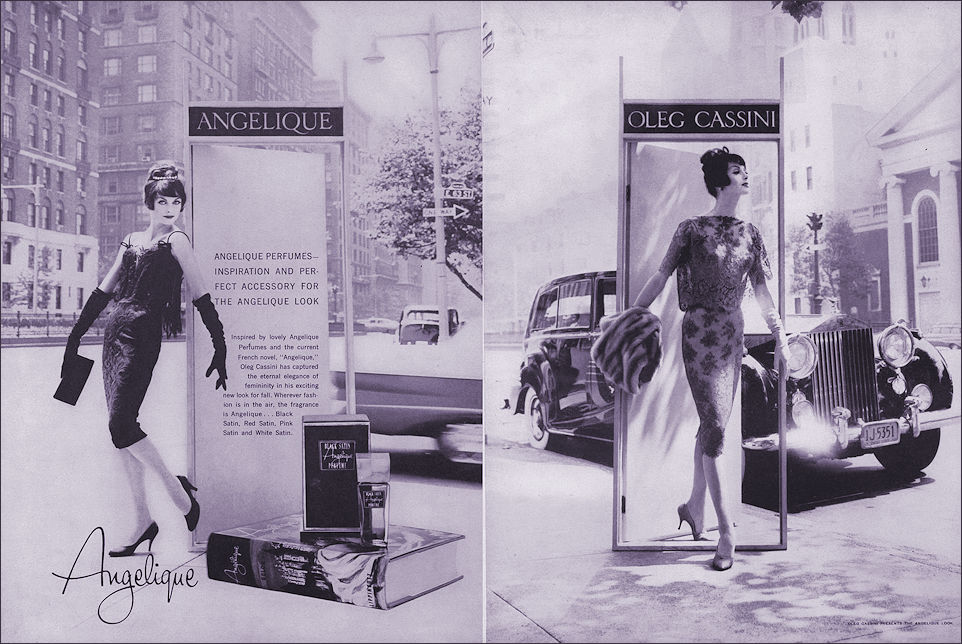Back to Anne Golon Home / Font
Source : Perfume Intelligence - The Encyclopaedia of Perfume - Where you are: Volume A: Angélique
Established by Lee Swartout and Charles N Granville in Wilton, Connecticut in 1946; subsidiary of Hazel Bishop; launched a range of fragrances and beauty products in the mid 1950s
White Satin - Angélique & Co-1949 / Pink Satin - Angélique & Co-1950 / Angélique - Angélique & Co-1950 / Red Satin - Angélique & Co-1954
Black Satin - Angélique & Co - 1958 - A cologne / Gold Satin - Angélique & Co - 1958
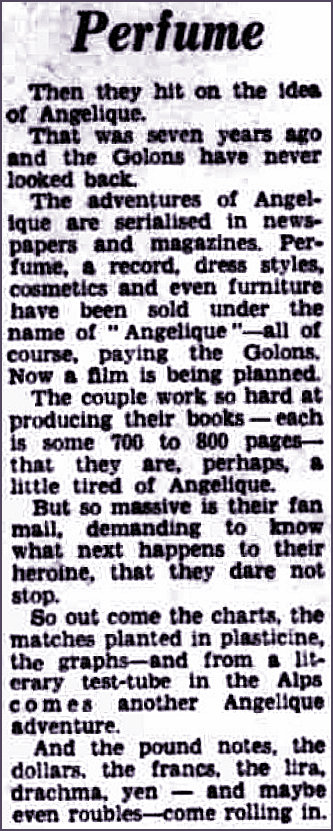
Detail from an article in The Daily Herald - Tuesday 27th August 1963 via the British Newspaper Archive and the confirmation that an 'Angélique' perfume was in the pipeline ......
Perfume
Then they hit on the Idea of Angélique. That was seven years ago and the Golons have never looked back. The adventures of Angélique are serialised in newspapers and magazines. Perfume, a record, dress styles, cosmetics and even furniture have been sold under the name of "Angélique " — all of course, paying the Golons. Now a film is being planned. The couple work so hard at producing their books each is some 700 to 800 pages - that they are, perhaps, a little tired of Angélique. But so massive is their fan mail, demanding to know what next happens to their heroine, that they dare not stop. So out come the charts, the matches planted in plasticine, the graphs — and from a literary test-tube In the Alps comes another Angélique adventure. And the pound notes, the dollars. the francs, the lira. drachma, yen - and maybe even roubles — come rolling in.
'Angélique perfumes - inspiration and perfect accessory for the Angélique look.
Inspired by lovely Angélique Perfumes and the current French novel "Angélique," Oleg Cassini has captured the eternal elegance of femininity in his exciting new look for fall. Wherever fashion is in the air the fragrance is Angélique ... Black Satin, Red Satin, Pink Satin and White Satin' - Sourced from Vogue Issue 1st October 1958
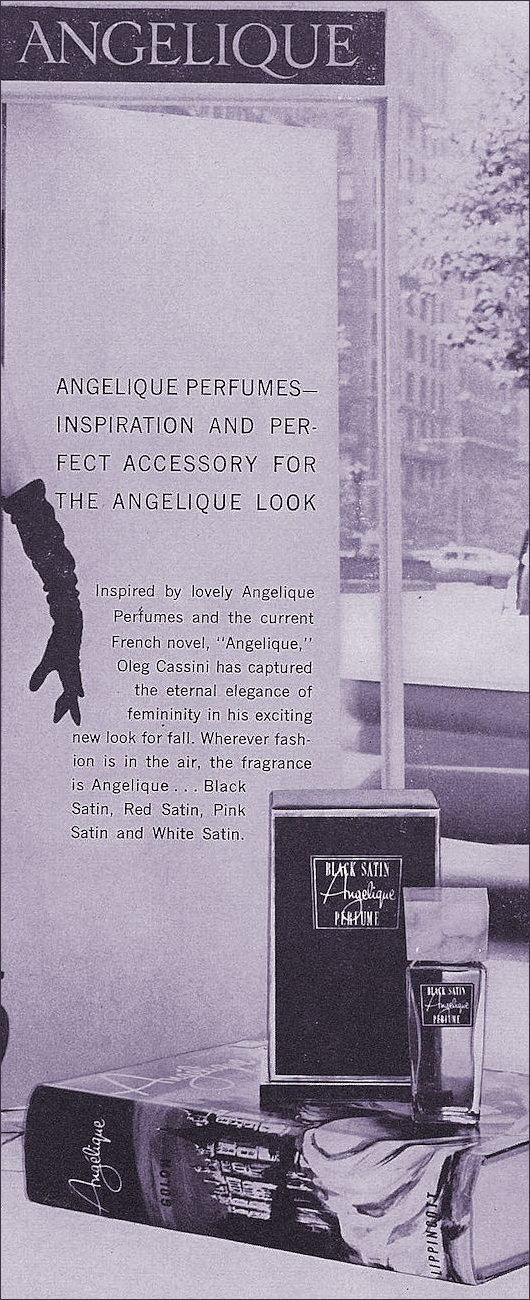
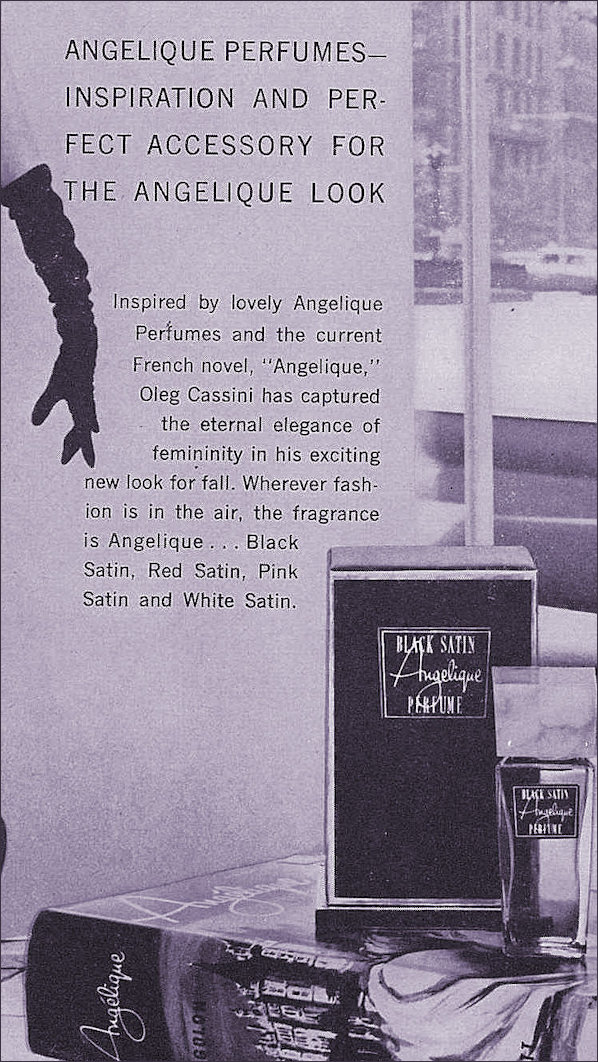
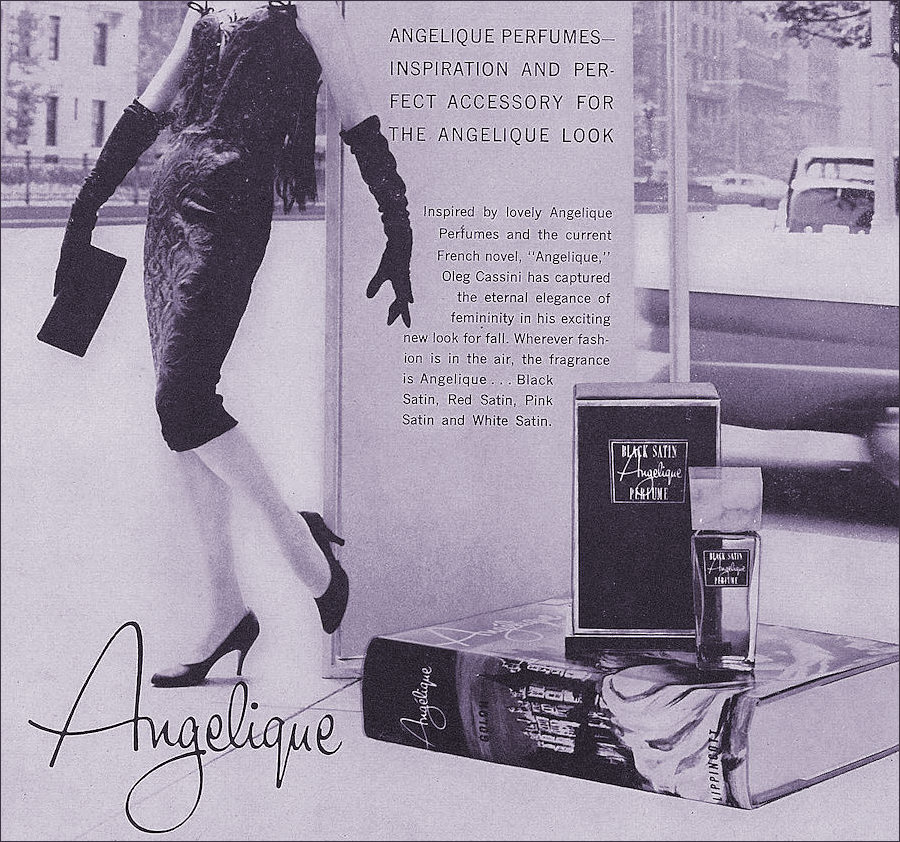
Details from the original advertisement in Vogue - Sourced from Vogue Issue 1st October 1958
What's it all about?
What is it all about? One thing that is certain, despite the spookily clairvoyant advert representing Puritan* women in a stockade, this perfume was specifically created by Cassini and was used as a companion to advertise itself and Anne and Serge's 'Angélique' original book. The perfume label uses the same eponymous name and font! (Not yet identified but I am working on it!) *'Angélique in Revolt' and 'La Route de l'Espoir'
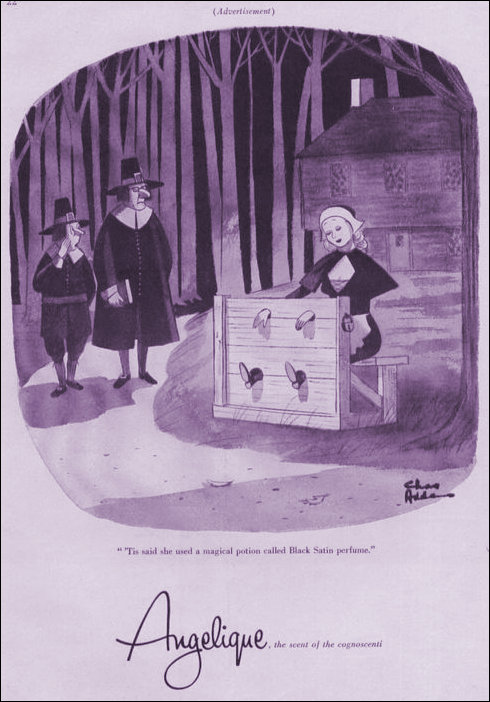
Advert for Angélique & Co's 'Black Satin' featuring a Puritan Woman in a stockade with one of the men giving us the reason for her punishment as " 'Tis said she used a magical potion called Black Satin perfume.' " - Underneath the company strapline boasts 'Angélique, the scent of the cognoscenti.' (Connoisseur, expert, specialist)
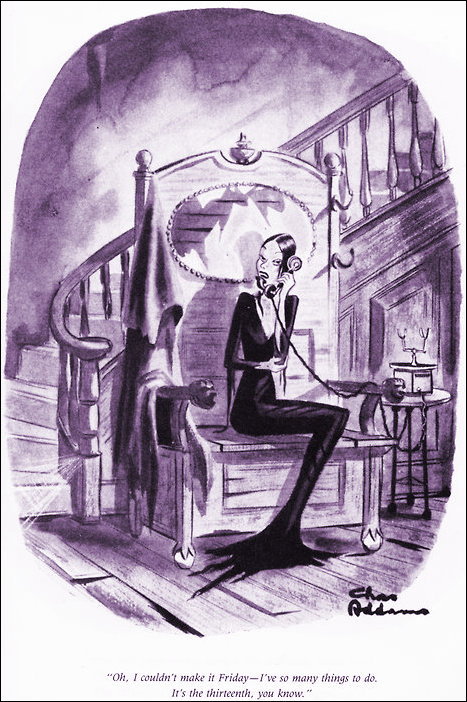
Morticia Addams "Oh, I couldn't make it Friday - I've so many things to do. It's the thirteenth, you know."
Oh dear, have I lost the plot? What on earth has Morticia to do with the books of 'Anne and Serge Golon?' Nothing - but look carefully and you will see that the illustrator of both is Chas Addams. The next coincidence is the unusual spelling of the surname of Addams (two ds instead of the more usual one) which is familiar to all fans of 'The Addams Family' of which Morticia is the the undisputed star and matriarch!
Short Biography of Chas Addams
From Biography.com (reduced)
Charles Addams was an American cartoonist whose work was frequently featured in The New Yorker. His most famous creation was the humorously macabre Addams Family.
He was born on January 7, 1912, in Westfield, New Jersey. The son of Charles Huey Addams, a piano company executive, and his wife, Grace M. Spear Addams, young Charles demonstrated an appreciation for the macabre at an early age. He had a deep fascination for coffins and skeletons, as well as a good practical joke.
His father, who had originally studied to be an architect, encouraged his son to draw at a young age. He attended Westfield High School then went on to Colgate University for two years before transferring to the University of Pennsylvania, where he finished his college degree. Addams then relocated to New York City, where he enrolled at the Grand Central School of Art. In 1935, he was hired by The New Yorker as a regular cartoonist, The pay was modest—just $35 per cartoon—but the magazine allowed Addams to explore his voice and imagination as well as hone the dark humor that would come to define his work, and allow him to create his famous, "creepy and kooky" Addams Family, later adapted for television and film productions.
After a three-year stint in the U.S. Army in the early 1940s, Addams returned to New York, where his work was widely received, from a variety of fans. His popularity extended to some of the biggest names in Hollywood. Cary Grant wanted to meet the man who called himself "A Defrocked Ghoul," as did Alfred Hitchcock, who once showed up at Addams's New York home unannounced to see the cartoonist in the flesh.
By the early 1980s, Addams's work had comprised 12 book collections and been exhibited at institutions like the Fogg Art Museum, the Metropolitan Museum of Art, and the Rhode Island School of Design, as well as many others. He famously signed his work, Chas Addams, intentionally short-handing his first name because, he explained, "it looks better than writing out Charles."
Among his many honors over the course of his lifetime, Addams won the Humor Award from Yale, an honorary doctorate from the University of Pennsylvania, as well as a special award from the Mystery Writers of America.
Thrice married Addams, who famously signed his work "Chas Addams," died in 1988.
How the concept of the Addams Family took off
From paleycenter.org (reduced)
The cartoon which started it all was for, of all things, a vacuum cleaner ad - the rest as they say is history :
"Above, from behind some broken railings, is an indecipherable creature overseeing the action. The joke came from the fact that the clueless pitchman is standing in what appears to be a haunted house, its gloominess punctuated by cobwebs and a bat. Addams would later describe the lady in the illustration, whom he dubbed the “witch-woman,” as “my idea of a pretty girl” and leave it at that.
It was New Yorker founder and editor Harold Ross who suggested Addams bring the characters back for further cartoons. The nameless “witch-woman” and her servant (now clean-shaven) therefore returned the following year, but what really made Addams’s name was his January 12, 1940, cartoon, unrelated to these characters, which showed a skiing woman having just passed a tree, the tracks of her skis mysteriously appearing on each side of the trunk. So good was the response to this drawing that an even wider number of readers began associating the artist’s name with the black humor that was his speciality. In the meantime, the un-named family of ghouls was expanding.
On November 14, 1942, the “witch-woman” was given a mate, a pudgy, smarmy fellow with a pencil moustache, hair parted in the middle, and a piggy nose, giving him a look not unlike Peter Lorre. Two children eventually appeared as well: a mischievous boy in a striped shirt and a dour little girl in pigtails, as well as a hag with straw-like hair who was presumably the grandmother of the house. A fellow with a bald head, bulging eyes and a huge coat with a fur collar was seen smiling in a movie audience while everyone else around him expressed shock or tears at what they were seeing. He too became a frequently reprised character, although his relationship to the others was left vague. During the 1940s and 50’s, a total of fifty-eight of these “family” cartoons appeared in the pages of the New Yorker.
The cartoonist even worked beyond the New Yorker, creating ads for Angélique perfume and Remington typewriters among others, as well as doing the artwork for Columbia Pictures’ 1957 black comedy How to Murder a Rich Uncle."
The Advertisements Gallery
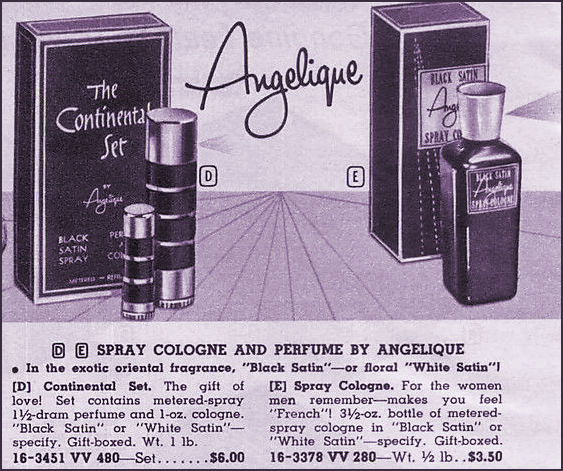
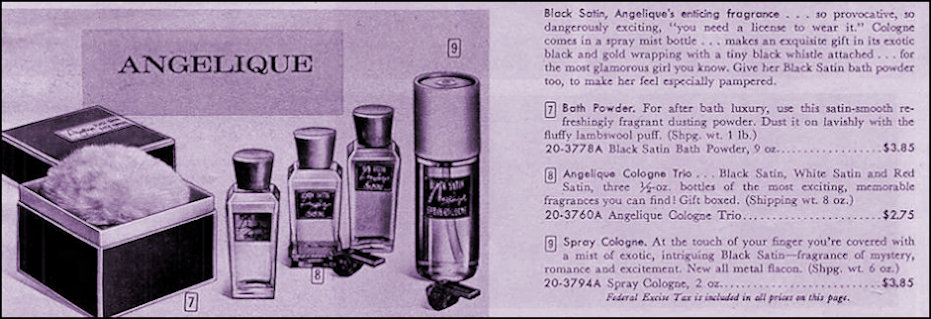
'So provocative, so dangerously exciting, you need a license to wear it' - great selling point!
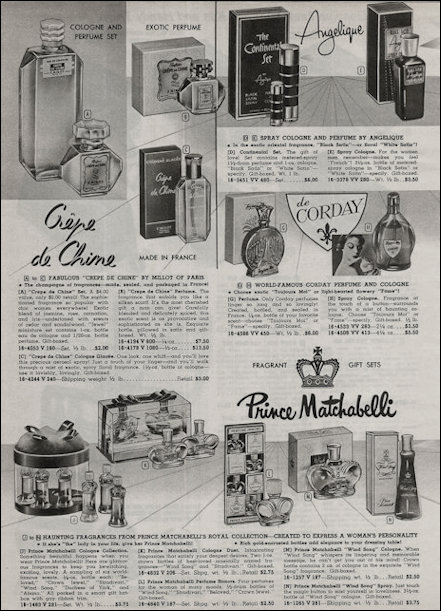
As originally shown in magazine advertisements - greater detail is shown in the images above
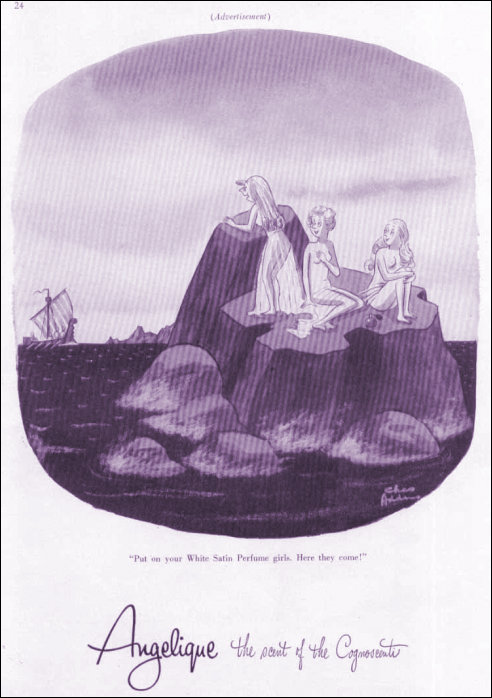
'Put on your White Satin Perfume girls. Here they come!'
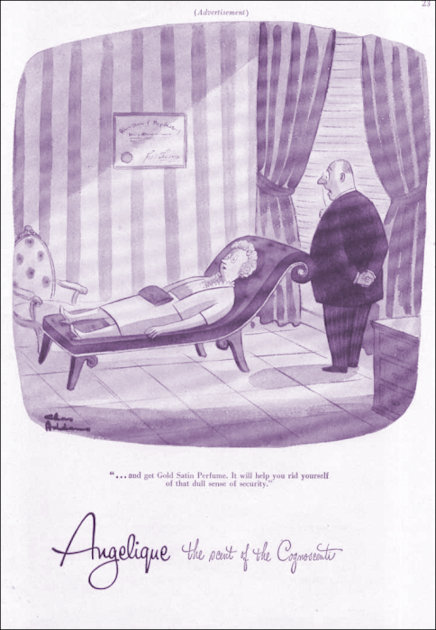
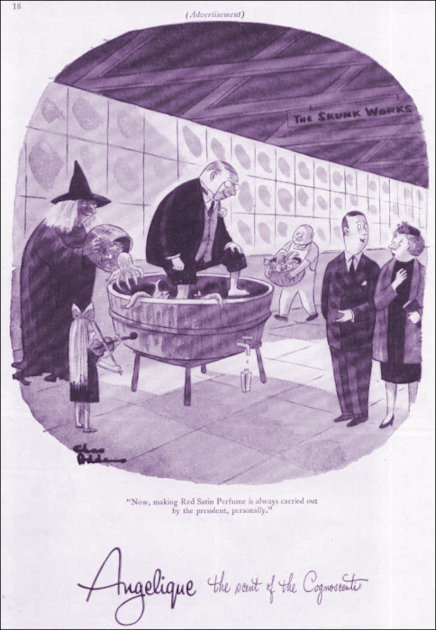
l to r (Gold) " .... and get the Gold Satin perfume. It will help you rid yourself of that dull sense of security" / (Red) "Now, making Red Satin Perfume is always carried out by the president, personally."
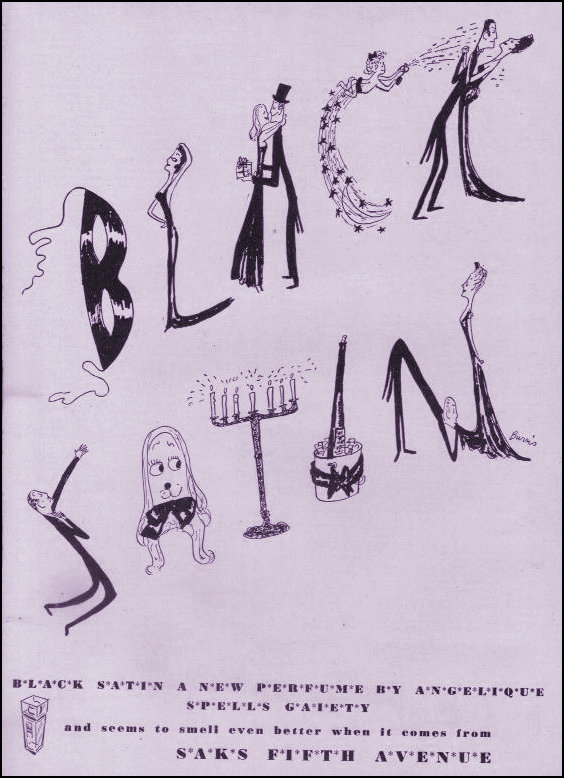
Moving away from the previous style and no mention of Chas Addams, maybe to accommodate the Saks 5th Avenue corporate image here the strapline incorporates the sellers 'Black Satin - a new perfume by Angélique spells gaiety and seems to smell even better when it comes from Saks Fifth Avenue'
The Ad Man's Nightmare
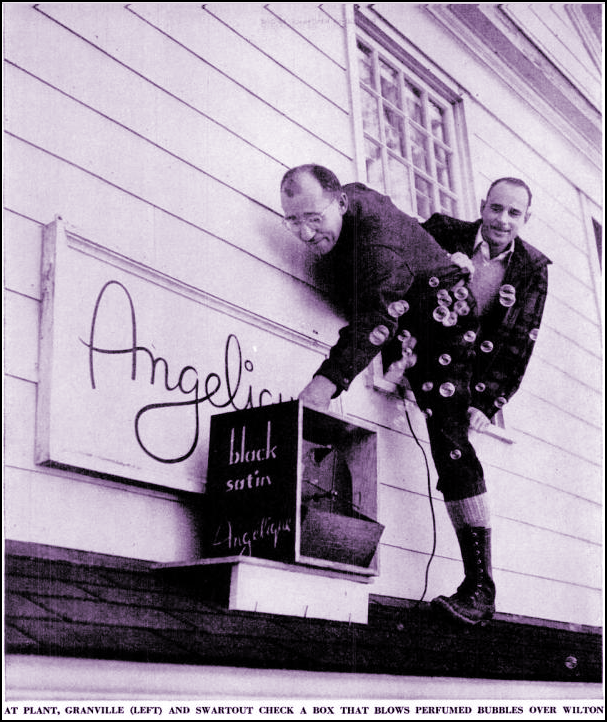
Sometime. someplace, somewhere circa 1950! Image © and courtesy of 'Life' Magazine 4th December 1950
The Perfume Gallery
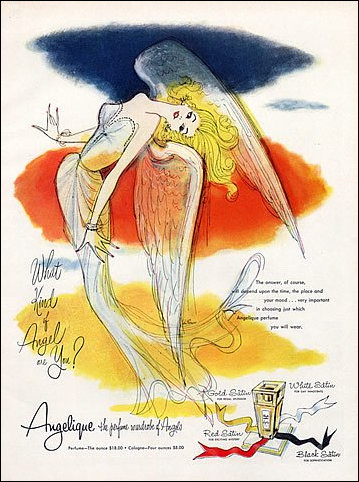
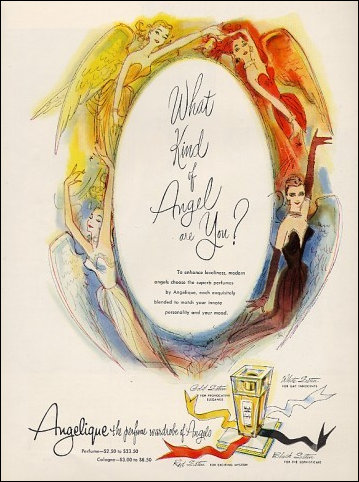
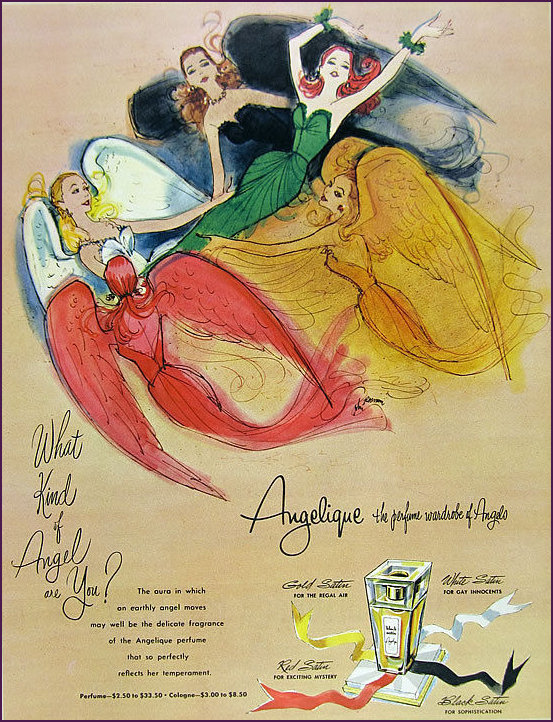
Promotional material this time asking 'What kind of Angel are you?' and running the strapline 'The perfume wardrobe of Angels' circa 1955
The Range
Regrettably at this stage I am unable to show any 'Pink Satin' or 'Angélique' examples :
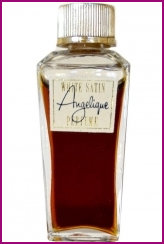
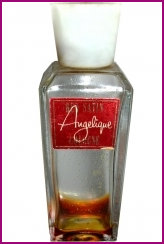
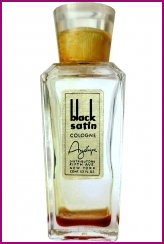
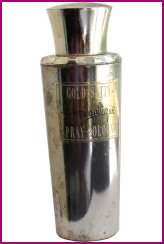
l to r (Chronologically) White Satin / Red Satin / Black Satin / Gold Satin
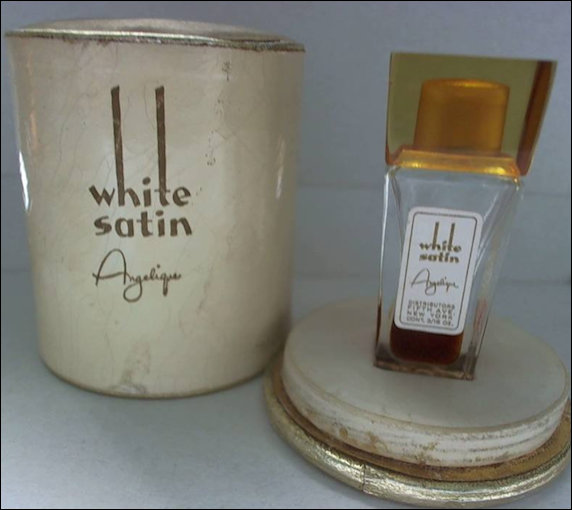
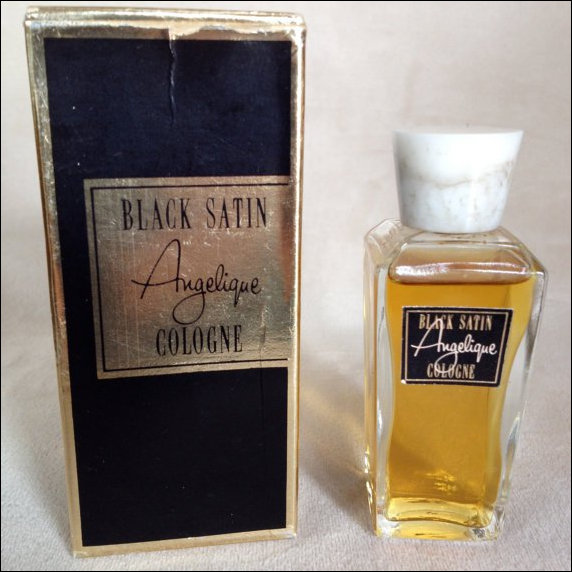
Of course packaging is everything too!
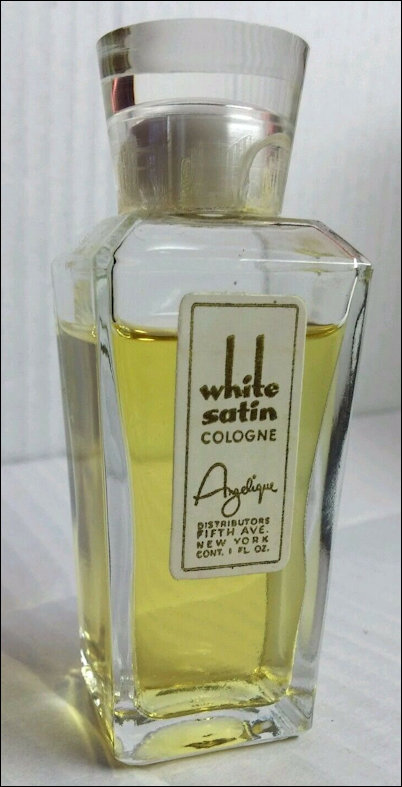
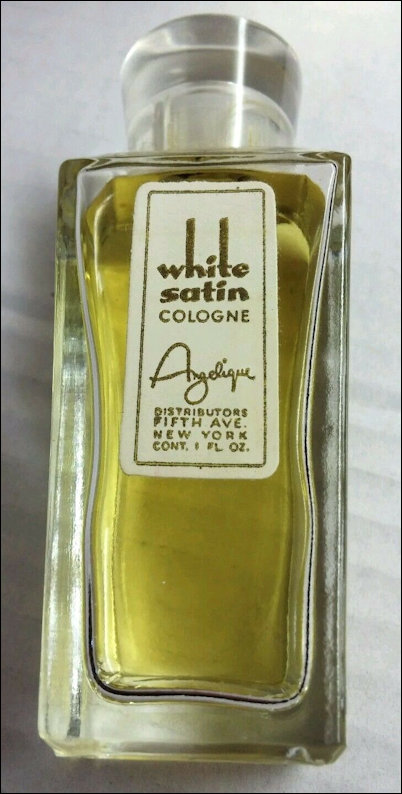
The 'White Satin' version of the perfume carrying the 'Angélique' font familiar on the hardback edition of the books. Left and right images sourced from picklickimg.com
Page created : 5th September 2016 | Page refreshed and re-appraised : 10th May 2021 (G)
